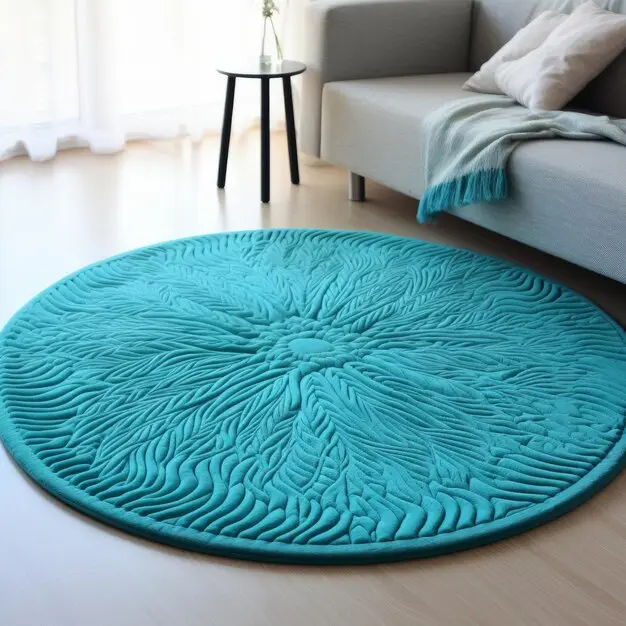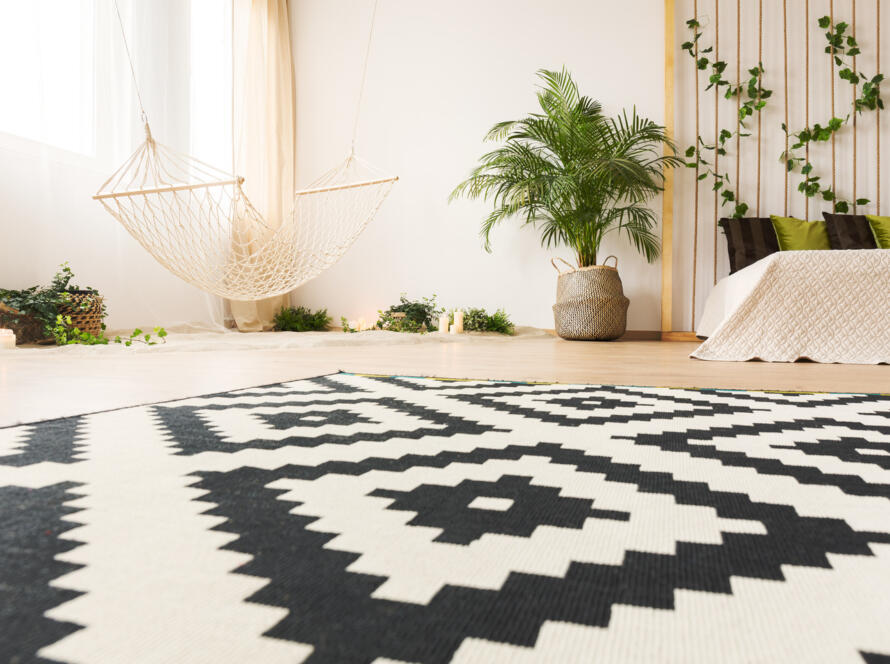
In the world of interior design, luxury handmade rugs occupy a space that is both functional and artistic. These rugs are not mere floor coverings; they are exquisite pieces of art that have the power to transform any room they grace. Their intricate designs and rich history make them a symbol of style and sophistication, appealing to those who appreciate both beauty and craftsmanship. This article delves deep into the allure of luxury handmade rugs, exploring their unique designs, the craftsmanship that brings them to life, and their profound impact on interior spaces.
The Art of Crafting Luxury Handmade Rugs

The creation of luxury handmade rugs is an intricate process that demands exceptional skill and precision. Each rug represents a labor of love, a testament to the artistry and dedication of the craftspeople who pour their expertise into every step of its creation. From selecting the finest materials to weaving intricate patterns, every aspect is meticulously executed to ensure the highest quality and aesthetic appeal.
Materials and Techniques
Luxury handmade rugs are crafted from a diverse array of materials, each chosen for its unique properties. Wool, silk, and cotton are among the most commonly used fibers. Wool is prized for its durability and warmth, while silk offers a lustrous sheen and delicate texture. Cotton provides a sturdy foundation that enhances the rug’s longevity.
The choice of material significantly influences the rug’s appearance, feel, and durability. Wool rugs, for instance, tend to be plush and insulating, making them ideal for colder climates. Silk rugs, on the other hand, are often used as statement pieces due to their luxurious finish and intricate detailing.
The techniques used in crafting these rugs are as varied as the regions from which they originate. Hand-knotting, hand-tufting, and flat weaving are some of the most renowned methods. Hand-knotting involves tying individual knots to create detailed patterns, resulting in a dense and durable rug. Hand-tufting is a quicker method that uses a tufting gun to insert fibers into a canvas, allowing for more elaborate and varied designs. Flat weaving, characterized by its lack of pile, creates a thinner, reversible rug that is often adorned with geometric patterns.
The Role of Dyes and Colors
Dyes play a crucial role in the creation of luxury handmade rugs, offering a spectrum of colors that breathe life into the patterns. Natural dyes, derived from plants, minerals, and insects, have been used for centuries to achieve rich, lasting hues. These dyes not only provide vibrant colors but also ensure that the rug ages gracefully, with colors that mellow beautifully over time.
The process of dyeing requires precise knowledge and skill, as the interaction between dye and fiber can vary based on factors like temperature and pH levels. Artisans must carefully control these elements to achieve the desired shade and ensure colorfastness.
Regional Influences and Styles
The design and craftsmanship of luxury handmade rugs are deeply influenced by the cultural and geographical context of their origin. Persian rugs, for example, are renowned for their intricate floral motifs and elaborate borders, while Turkish rugs often feature bold colors and geometric patterns. Indian rugs may showcase a fusion of styles, reflecting the diverse influences present in the region.
The growing interest in authenticity and quality has also extended beyond the world of textiles to other sectors, such as pharmaceuticals. With more consumers seeking to buy Cenforce 100 online here, there is increasing attention on the origins and handling of these products. Questions about the reliability of suppliers, quality assurance, and safe delivery have become just as important as those surrounding traditional craftsmanship. Navigating this landscape requires a discerning approach, much like selecting the finest materials and techniques for a luxury handmade rug.
Each region brings its unique aesthetic and technique to rug-making, resulting in a rich tapestry of styles that cater to a wide range of tastes. Understanding these regional influences can enhance one’s appreciation for the artistry and cultural significance embodied in each rug.
The Allure of Unique Designs

Handmade rugs are celebrated for their unique designs, which often reflect the cultural heritage and artistic vision of the weaver. These designs can range from traditional motifs to modern abstract patterns, offering something for every taste and style preference.
Traditional Designs and Their Symbolism
Traditional designs in handmade rugs are steeped in history and symbolism. Motifs inspired by nature, such as flowers, animals, and trees, are common, each carrying its own meaning. For instance, a floral pattern might symbolize beauty and growth, while animal motifs could represent strength or protection.
Geometric shapes and symbolic imagery also play a significant role in traditional designs. These elements are often used to convey stories or cultural beliefs, with each pattern holding a specific significance. Understanding the symbolism behind these designs can deepen the connection to the rug and its cultural roots.
Contemporary Designs and Aesthetic Trends
Contemporary designs in luxury handmade rugs embrace modern aesthetics, often characterized by bold colors, abstract forms, and minimalist patterns. These rugs cater to those who seek to make a stylish statement in a modern home, offering a fresh and innovative take on traditional rug-making.
The rise of contemporary designs reflects broader trends in interior design, where clean lines, open spaces, and a focus on individuality are celebrated. Rugs with abstract patterns can serve as focal points in a room, drawing attention and sparking conversation. Meanwhile, minimalist designs add a subtle elegance, complementing a variety of décor styles.
Customization and Personalization
One of the most appealing aspects of luxury handmade rugs is the ability to customize them to suit personal preferences. Many artisans offer bespoke services, allowing clients to choose colors, patterns, and sizes that align with their specific needs and tastes. This level of personalization ensures that each rug is a perfect match for its intended space, reflecting the owner’s unique style.
Customization extends beyond aesthetics to include practical considerations such as size and shape. A custom rug can be tailored to fit an unusual space or accommodate specific furniture arrangements, enhancing both the functionality and visual harmony of the room.
The Role of Handmade Rugs in Interior Design

Luxury handmade rugs are more than just floor coverings; they play a crucial role in interior design, influencing the overall look and feel of a space. They can define areas, add warmth, and introduce color and texture, making them essential elements in creating a cohesive and inviting environment.
Defining Spaces in Open-Plan Layouts
In open-plan homes, rugs are invaluable tools for defining distinct areas within a larger space. A strategically placed area rug can anchor the living room, creating a visual boundary that separates it from the dining area or kitchen. This not only establishes a sense of order and structure but also enhances the flow and functionality of the space.
Rugs can also be used to highlight specific zones, such as a reading nook or a home office within a larger room. By delineating these areas, rugs contribute to a more organized and purposeful layout.
Adding Warmth, Comfort, and Acoustic Benefits
Rugs add warmth and comfort underfoot, transforming hard, cold floors into inviting surfaces that encourage relaxation. This is especially important in rooms with tile, stone, or hardwood flooring, where a soft rug can provide a welcome reprieve from the rigidity and chill.
Beyond physical comfort, rugs offer acoustic benefits by absorbing sound and reducing noise levels. In large or sparsely furnished rooms, rugs can help mitigate echoes and create a quieter, more serene atmosphere.
Introducing Color, Texture, and Artistic Flair
A luxury handmade rug can introduce a splash of color or a new texture to a room, enhancing its visual appeal. Whether it’s a vibrant Persian rug that adds a pop of color or a subtle neutral design that complements existing décor, a rug can serve as a focal point or a harmonious backdrop.
Rugs also offer an opportunity to incorporate artistic flair into a space, acting as a canvas for intricate designs and patterns. By selecting a rug that aligns with the room’s color palette and style, homeowners can create a cohesive and aesthetically pleasing environment.
Investing in Luxury Handmade Rugs
While luxury handmade rugs can be a significant investment, their quality and longevity often justify the cost. These rugs are built to last, with many becoming cherished heirlooms passed down through generations, embodying both personal and cultural history.
Factors to Consider When Choosing a Rug
When investing in a luxury handmade rug, several factors should be considered to ensure a wise and satisfying purchase. Material is a critical consideration, as it affects the rug’s durability, feel, and maintenance requirements. Wool and silk are popular choices for their resilience and beauty, but other materials like cotton or jute may also be suitable depending on the intended use.
Craftsmanship is another important factor, with hand-knotted rugs often commanding higher prices due to the labor-intensive process and superior quality. The design should complement the existing décor and align with the room’s function, enhancing the overall aesthetic.
Size and shape are also crucial, as they impact the rug’s ability to fit seamlessly into the space. A rug that is too large may overwhelm a room, while one that is too small might look out of place.
Caring for Your Rug: Maintenance and Preservation

Proper care and maintenance are essential to preserving the beauty and lifespan of your luxury handmade rug. Regular cleaning, such as vacuuming and gentle shaking, can prevent dirt and debris from settling into the fibers. Prompt attention to spills and stains is crucial, as untreated blemishes can become permanent over time.
Professional cleaning services should be employed periodically to ensure a deep clean that preserves the rug’s integrity. Additionally, rotating the rug occasionally can prevent uneven wear and exposure to sunlight, helping to maintain its vibrant colors.
The Long-Term Value of a Luxury Rug
Investing in a luxury handmade rug is not merely a financial decision; it’s an investment in a piece of art that holds both aesthetic and sentimental value. Over time, these rugs can appreciate, especially if they are well-maintained and possess unique or rare qualities.
In addition to their monetary value, luxury rugs offer emotional and cultural significance, serving as reminders of travels, family heritage, or personal milestones. As they are passed down through generations, they become woven into the fabric of a family’s history, offering a tangible connection to the past.
Conclusion
Luxury handmade rugs are timeless pieces that bring beauty and elegance to any interior. Their unique designs and superior craftsmanship make them more than just decorative items—they are works of art that enhance the aesthetic and emotional value of a space. Whether you’re drawn to traditional motifs or contemporary patterns, these rugs offer endless possibilities for personal expression in your home.
Investing in a luxury handmade rug is not just about enhancing your space; it’s about acquiring a piece of history and artistry that you can cherish for a lifetime. As you explore the world of unique area rugs, let your personal style guide you to a piece that truly speaks to you. Embrace the opportunity to own a masterpiece that will not only adorn your home but also enrich your life with its timeless beauty and cultural significance.





1 Comment
Comments are closed.